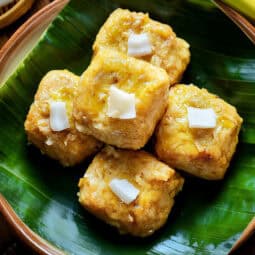
Nilupak na Saging (Filipino Mashed Banana)
Nilupak na Saging is a traditional Filipino merienda where saba bananas are boiled, pounded with freshly grated coconut and brown sugar in a wooden mortar and pestle, then shaped and finished with a generous brushing of butter, resulting in a smooth, mildly sweet delicacy typically served on warm banana leaves. This labor-intensive dish from rural Philippines showcases the art of transforming humble ingredients into a comforting treat that epitomizes Filipino culinary heritage.
Equipment
- Large pot (kaldero) for boiling bananas
- Wooden mortar and pestle (pangdikdik) traditional tool for mashing, Alternative: Food processor or potato masher
- Banana Leaves (Dahon ng Saging) for serving
- Sharp knife (panghiwa) for peeling bananas and cutting portions
- Measuring cups and spoons (Panukat) for precise measurements of ingredients
- Serving platter (bandehado) for serving
- Pastry brush for applying butter
Ingredients
- 15 pieces unripe saba bananas saging na saba
- ½ cup brown sugar asukal na pula
- 1 whole coconut freshly grated (niyog na kinayod)
- ½ teaspoon vanilla extract
- 4 tablespoons butter or margarine softened
- Banana leaves for serving optional
Instructions
- First, peel all 15 saba bananas and place them in a large pot. Fill the pot with enough water to cover all the bananas. Turn your stove to high heat (180°C/350°F) and bring the water to a boil.
- Once boiling, lower the heat to medium (150°C/300°F) and cook the bananas for 12-15 minutes. You can check if they're done by poking with a fork - it should go through easily. When they're tender, drain all the water and let the bananas cool slightly.
- Place the cooked bananas in your wooden mortar (lusong) or large bowl if using a potato masher. Pound or mash the bananas until completely smooth with no lumps. Take your time with this step to ensure a silky texture.
- Add the freshly grated coconut to your mashed bananas. If using the traditional method, continue pounding until well combined. Next, add the brown sugar and vanilla extract. Keep pounding or mixing until everything is evenly combined and smooth.
- If you're using banana leaves for serving, quickly pass them over a flame or hot stove to make them soft and shiny. Wipe them clean with a damp cloth. This step is optional but adds a wonderful traditional aroma.
- Transfer your mixture to a serving plate. Shape it into either a dome or flatten it to cut into squares later. Using a brush or spoon, generously coat the top with softened butter or margarine. If you prepared banana leaves, place them on your serving plate first, then add the linupak.
- Finally, cut your linupak into squares or diamond shapes. Serve while still warm for the best experience. You can enjoy it at room temperature too, but warm linupak has the most comforting texture and aroma.
- Remember to keep your hands slightly wet when shaping the mixture to prevent sticking. The whole process takes about 35 minutes, and the recipe serves 8-10 people.
Tips from Lola's Kitchen
- Use slightly underripe saba bananas for best texture
- Wilt banana leaves over fire or hot stove for authentic aroma
- Test banana doneness by piercing - overcooked bananas become watery
- For smoother texture, pound ingredients gradually
- Keep hands slightly wet when shaping to prevent sticking
Nutrition
Calories: 245kcalCarbohydrates: 42gProtein: 2gFat: 9gSaturated Fat: 1gSodium: 14mgPotassium: 19mgFiber: 3gSugar: 18gCalcium: 24mgIron: 0.3mg
Tried this recipe?Let us know how it was!